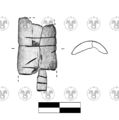SZ-23 antler
| Object | |
|---|---|
| Classification: | handle |
| Material: | antler |
| Size: | length: 3.5 cm, width: 1.9 cm, height: 6 mm |
| Condition: | damaged, fragmentary |
| Archaeological culture: | Late Iron Age |
|
| |
| Site: | Sanzeno (Trento, Trentino-Alto Adige, Italy) |
| Coordinates (approx.): | 46° 21' 57.60" N, 11° 4' 30.00" E [from site] |
| Find date: | November 1908 |
| Find circumstances: | old finding |
| Current location: | Tiroler Landesmuseum Ferdinandeum (repository) |
| Inventory Nr.: | 13.453 |
|
| |
| Inscription: | SZ-23 (]ilt[?) |
|
| |
| Sources: | PID: 19 et seq. IR: 282 (No. 63), pl. L, fig. a Nothdurfter 2002: 1150–1151 (list 3, No. 8) |
Images
|
Object SZ-23 antler with inscription SZ-23.
|
Commentary
Antler fragment.
Probably handle of a knife or another implement.
Broken in four small pieces of various dimensions; blackened by fire of which two are more highly blackened.
Recomposed the four pieces in the correct way, along an inscription.
Related to three of the four fragments Mancini notes that they were found in November 1908 in Sanzeno without giving reasons or further information (cp. LIR: 104 [SA-41]).
The dating to the Late Iron Age is reasoned by the appearance of the inscription.
Mancini states confusing indications related to the material: In IR: 63 he indicates antler as material, in LIR: 102 he characterises one fragment as made either of bone or of antler (SA-38), the other three fragments as made of bone (SA-41) in contrast to his edition of 1975 (cp. IR). However the whole fragment is of antler.
The fragments were correctly aligned by the project's archaeological draughtsperson (cp. drawing), which led to their identification with another inscription-bearing object: In PID, Whatmough, following Conway, described the object as a calcined broken fragment, probably of a knife-handle, similar to SZ-22 handle, and "damaged at the top as well as on the left edge". While it is possible that Whatmough, who did not see the object himself, misinterpreted Conway's notes, examination of the breaking edges shows that the fragments have come apart only recently. The fragment was probably still in one piece when Conway saw it in 1908 – bits of it may even have gone missing (cp. SZ-23). In any case, Mancini did not in this description recognise the fragments he saw in the Tiroler Landesmuseum Ferdinandeum, and republished object(s) and inscription(s) as probably unpublished (No. 63 I, II and III in IR). This duplication found its way into the corpus of Schumacher 1992 (cp. SZ-23 and SZ-64). Also Nothdurfter 2002 notes the recomposed object as two differents at which he indicates one fragment as section of a handle (Nothdurfter 2002: 1151). In his new edition Mancini indicates the four fragments as SA-38 ("un piccolo frammento di osso o corno"; LIR: 102) as well as SA-41 ("frammentini di osso semicombusti"; LIR: 104).
Autopsied by the Thesaurus Inscriptionum Raeticarum in November 2013.
S.K. with additonal information by C.S.
Bibliography
| IR | Alberto Mancini, "Iscrizioni retiche", Studi Etruschi 43 (1975), 249–306. |
|---|---|
| LIR | Alberto Mancini, Le Iscrizioni Retiche [= Quaderni del dipartimento di linguistica, Università degli studi di Firenze Studi 8–9], Padova: Unipress 2009–10. (2 volumes) |
